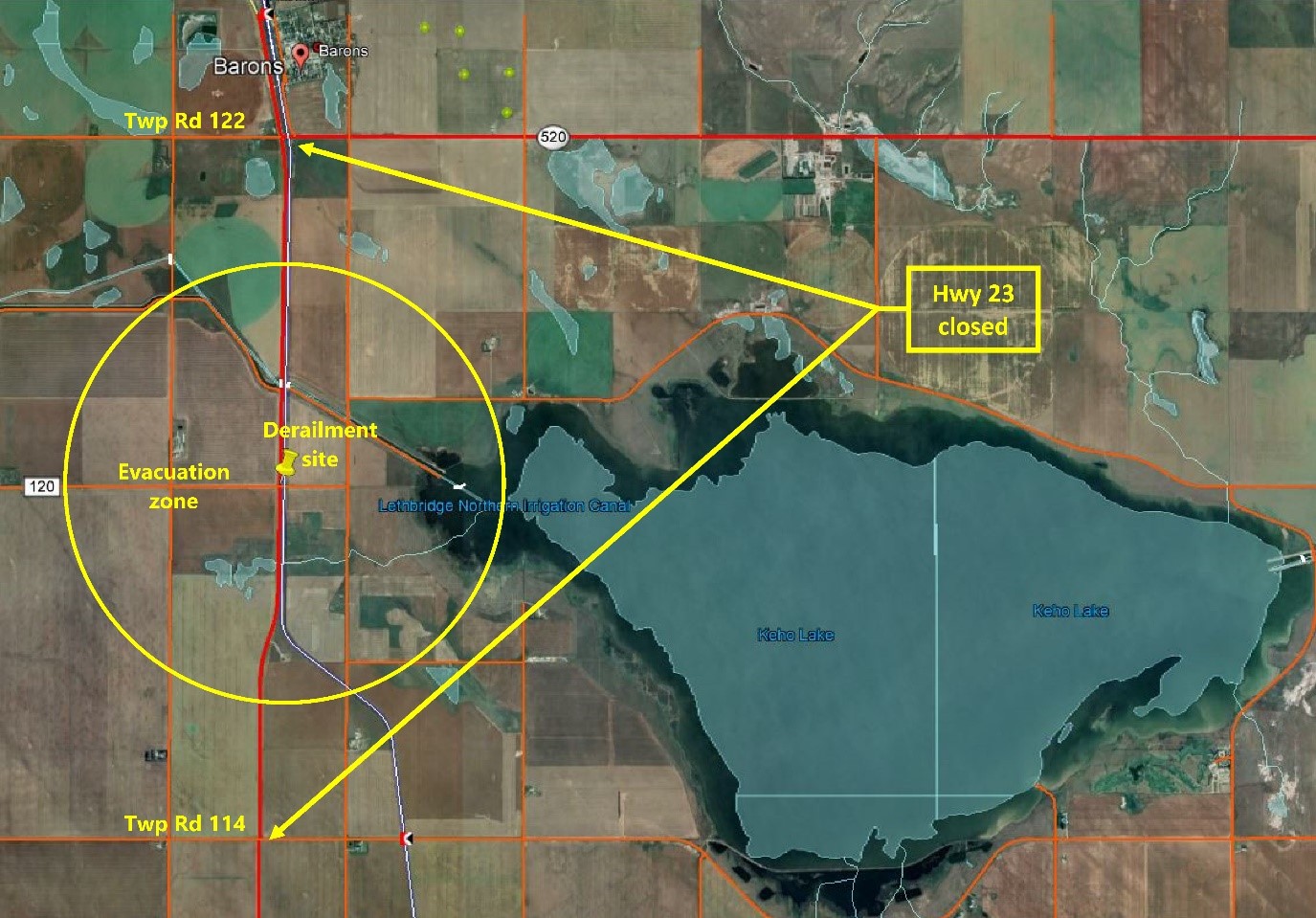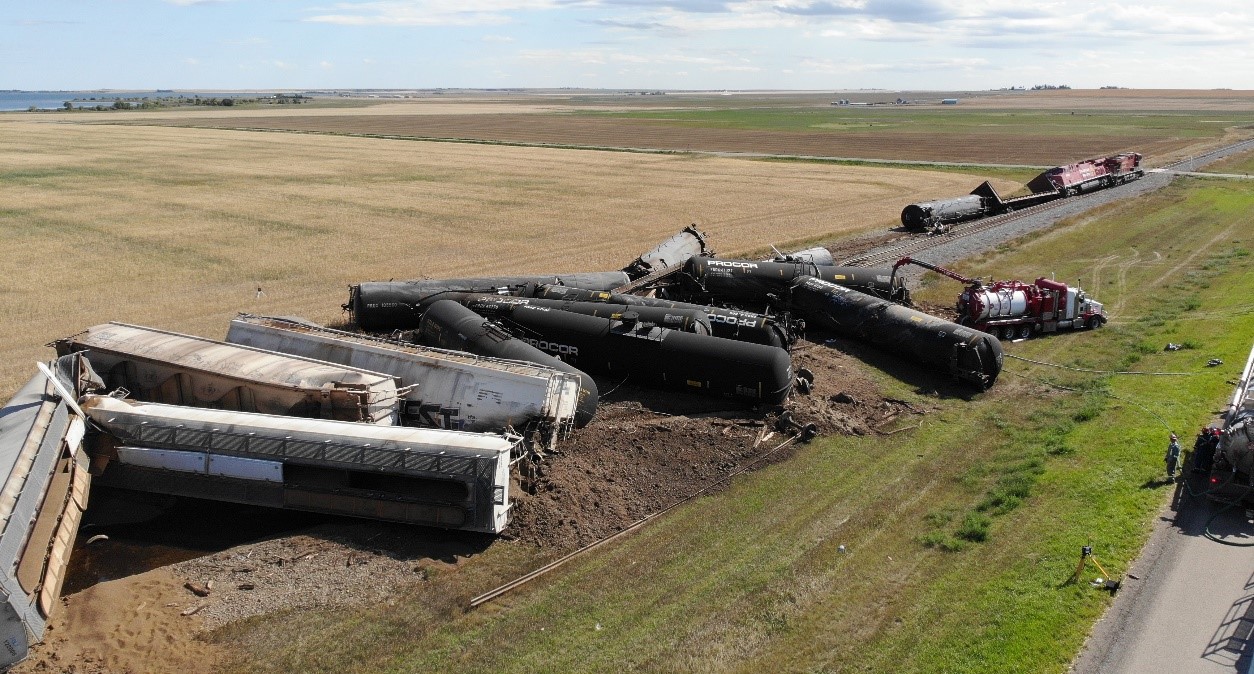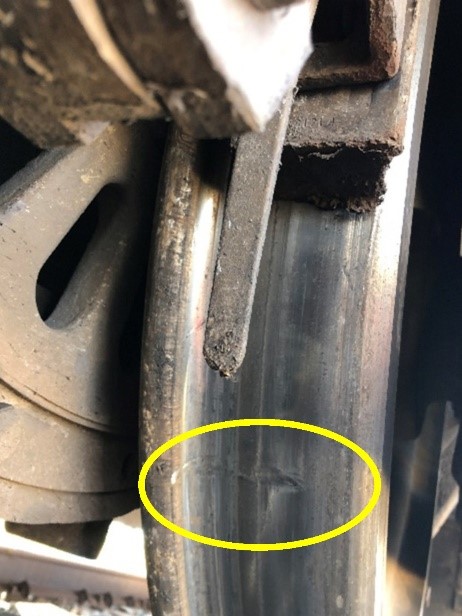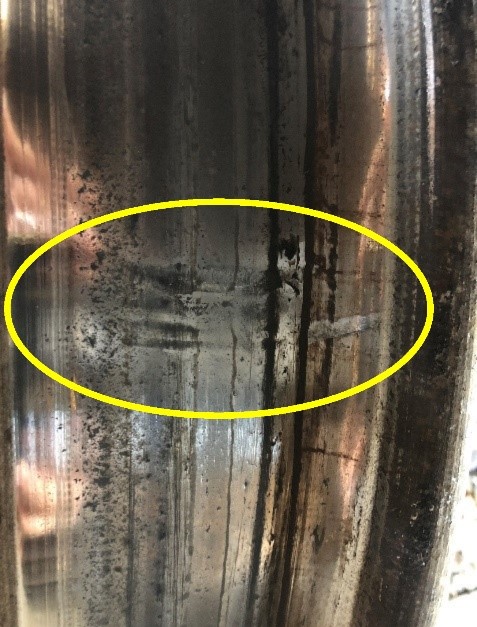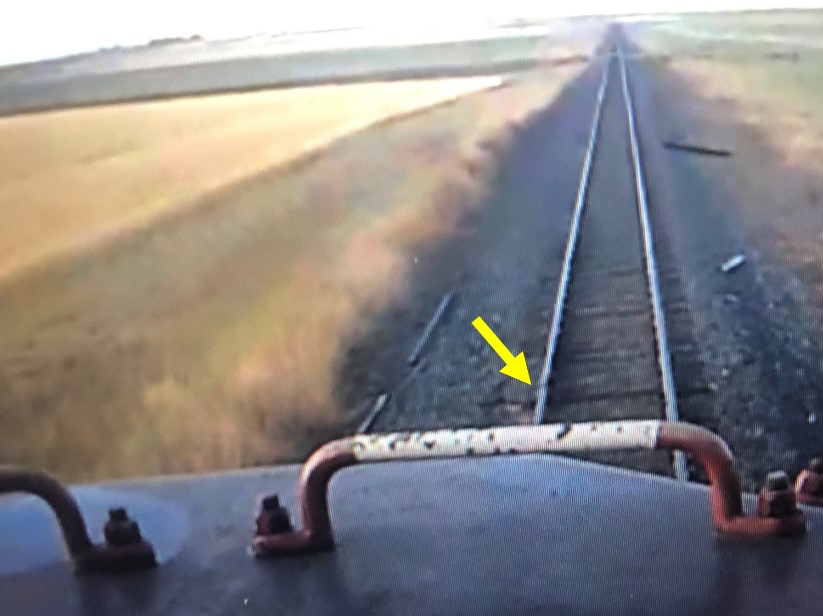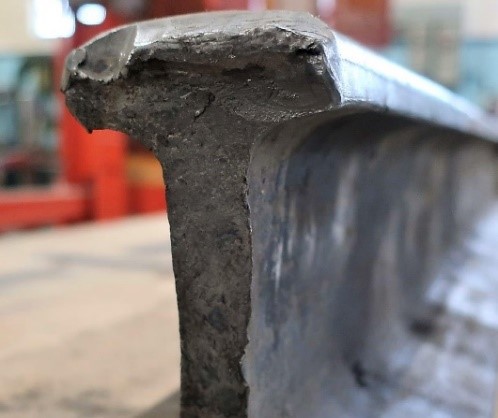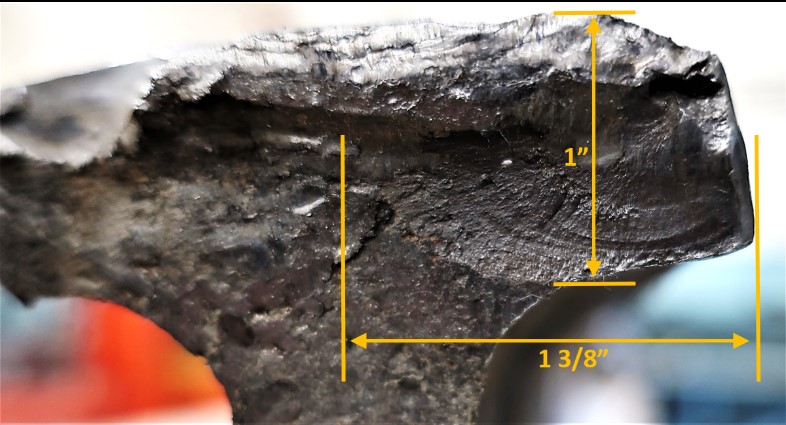Main-track train derailment and dangerous goods release
Canadian Pacific RailwayFreight train 469-01
Mile 17.88, Aldersyde Subdivision
Barons, Alberta
The Transportation Safety Board of Canada (TSB) investigated this occurrence for the purpose of advancing transportation safety. It is not the function of the Board to assign fault or determine civil or criminal liability. This report is not created for use in the context of legal, disciplinary or other proceedings. See Ownership and use of content. Masculine pronouns and position titles may be used to signify all genders to comply with the Canadian Transportation Accident Investigation and Safety Board Act (S.C. 1989, c. 3).
The occurrence
On 02 September 2019, a Canadian Pacific Railway (CP) operating crew was ordered for 0200Footnote 1 at CP Alyth Yard located in Calgary, Alberta, for train 469-01. The train was to operate southward from Calgary to Lethbridge, Alberta, on CP’s Aldersyde Subdivision. The train crew were qualified for their positions, met fitness and rest requirements and were familiar with the territory.
Train 469-01 was a distributed powerFootnote 2 train configured with 3 locomotives (2 on the head end and 1, remote controlled, on the tail end). It was hauling 96 freight cars (67 loaded cars, 25 empty cars, and 4 residue cars), weighed approximately 9775 tons, and was about 6070 feet long.
The train, designated as a key train,Footnote 3 departed Alyth Yard at about 0500 carrying loads of anhydrous ammonia, octanes, canola oil, asphalt, diesel fuel, and liquid petroleum gas, and various empty and residue rail cars.
At 0743, while the train was proceeding at 40 mph, a train-initiated emergency brake application occurred at Mile 17.8, about 4 kilometers south of the town of Barons, Alberta. After the train came to a stop, the crew inspected the train and determined that the 2nd head-end locomotive and the following 21 cars, 11 of which were tank cars, had derailed. It was also evident that several tank cars containing dangerous goods (DGs) were leaking.
At 1050, vehicular traffic was rerouted around the occurrence area and an evacuation order was put in place for communities within a 2-kilometre radius of the derailment site (Figure 1). The order included the Keho Lake area, golf course and campground, from where an estimated 400 people were evacuated, as well as 6 homes, from where 12 residents were evacuated. The village of Barons was outside the evacuation zone and was put on evacuation notice as a precautionary measure. The evacuation order was lifted at around 1600 after the site was deemed safe.
No injuries or fire were reported. The weather was clear with unlimited visibility and the ambient temperature was around 13.5 °C.
Site examination and equipment information
The derailment site was located immediately adjacent to Highway 23 in a rural area between Barons and Nobleford, Alberta. The derailed rolling stock came to a rest on both sides of the track (Figure 2). The site was secured and all access points to the site were controlled.
The point of derailment was at Mile 17.88 on the Aldersyde Subdivision, on a section of tangent track about 500 feet north of the road crossing for Township Road 120 (Mile 17.79). Approximately 600 feet of track had been damaged or destroyed. The lead locomotive (CP 8744), which had not derailed, had come to a stop about 25 feet north of the crossing. The 2nd locomotive (CP 8048) had remained coupled to the 1st locomotive, but all wheels on the rear truck had derailed resulting in the locomotive body leaning towards the east side of the track. The first 2 derailed cars, an empty bulkhead flatcar and a loaded tank car, had remained coupled to the 2nd locomotive and were leaning to the east. The balance of the 21 derailed cars were on their side in a jack-knife pattern and were confined to a relatively small area. Of these 21 cars, 11 were loaded tank cars, 10 of which contained dangerous goods (Table 1). The remaining 75 cars on the train and the tail-end remote controlled locomotive did not derail.
| Position in train | Equipment identification | Tank car design | Length (feet) | Gross weight (tons) | Lading weight (tons) | Contained DG | DG volume (litres) | DG released (litres) | Hazmat code, class and shipping name |
|---|---|---|---|---|---|---|---|---|---|
| 4 | PROX 105049 | DOT-112 (112J500I) | 67 | 130 | 76.4 | Y | N/A | N/A | UN 1005, class 2.3, anhydrous ammonia |
| 5 | ITWX 33020 | DOT-112 (112J340W) | 69 | 130 | 79.2 | Y | N/A | N/A | UN 1005, class 2.3, anhydrous ammonia |
| 6 | PROX 105560 | DOT-112 (112J500I) | 67 | 130 | 76.2 | Y | N/A | N/A | UN 1005, class 2.3, anhydrous ammonia |
| 8 | PROX 47327 | DOT-111 (111S100W) | 59 | 130 | 77.1 | Y | 107 374 | 85 610 | UN 1262, class 3, octanes |
| 9 | PROX 47315 | DOT-111 (111S100W) | 59 | 130 | 77.1 | Y | 106 098 | 1293 | UN 1262, class 3, octanes |
| 10 | PROX 45505 | DOT-111 (111S100W) | 59 | 130 | 77.1 | Y | N/A | N/A | UN 1262, class 3, octanes |
| 11 | PROX 47278 | DOT-111 (111S100W) | 59 | 130 | 77.1 | Y | 106 104 | 52 587 | UN 1262, class 3, octanes |
| 12 | PROX 47132 | DOT-111 (111S100W) | 59 | 130 | 77.1 | Y | N/A | N/A | UN 1262, class 3, octanes |
| 13 | UTLX 667442 | AAR 211 (111A100W) | 60 | 130 | 93.3 | N | N/A | N/A | N/A (non-DG), canola oil |
| 22 | UTLX 662498 | DOT-111 (111S100W) | 55 | 130 | 89.9 | Y | N/A | N/A | UN 3257, class 9, elevated temperature liquid (asphalt) |
| 23 | PROX 230957 | DOT-111 (111S100W) | 55 | 130 | 89.9 | Y | N/A | N/A | UN 3257, class 9, elevated temperature Liquid (asphalt) |
Sources:
- Position in train: TSB
- Equipment identification: TSB
- Tank car design: UMLER database
- Length: UMLER database
- Gross weight: UMLER database
- Lading weight: CP
- Contained DG: CP
- DG volume: CP
- DG released: CP
- Hazmat code, class and shipping name: TSB
Impact damage to the bottom outlet valve assembly created leaks on 3 overturned tank cars that resulted in the release of approximately 139 490 litres of octanes . Octanes (UN 1262) are a Class 3 flammable liquid.
Visual inspection of the wheel tread surfaces on the lead locomotive, which had not derailed, revealed imprint scuff marks on the L4, L5, and L6 wheels that had been travelling along the east rail (figures 3 and 4). This is consistent with the wheel tread surface contacting a fracturing or fractured rail surface on the east rail.
Three non-mating pieces of the east rail were recovered from the derailment site. Initial inspection suggested this rail was most likely not from the derailment initiation point, but rather was from another location and was damaged in the derailment. The rail was retained for further analysis by CP.
Recorded information
A review of the locomotive event recorder download determined that the train was handled in accordance with all regulatory and company requirements with no operating anomalies observed.
Forward-facing locomotive video
The lead locomotive was equipped with a forward-facing camera and video-recording equipment. A post-derailment review of the video data revealed a fracture in the east rail (Figure 5).
Note: Track materials in the photo are from a previous track repair. (Source: Canadian Pacific Railway video)
Additionally, video footage was obtained from an earlier train that had passed through the area at approximately 0212, about 5⅟₂ hours before the occurrence. The video was reviewed in an attempt to determine whether the rail fracture had already started to develop. However, the resolution of the video was limited due to the nighttime darkness and therefore proved to be inconclusive.
Subdivision and track information
The Aldersyde Subdivision is a single-track secondary mainline 116 miles in length that runs in a north–south direction between CP’s main terminal in Calgary and a CP yard in Lethbridge. Train movements on the Aldersyde Subdivision are controlled by the occupancy control system (OCS), as authorized by the Canadian Rail Operating Rules (CROR), and supervised by a rail traffic controller (RTC) located in Calgary. This subdivision is designated a key routeFootnote 4 under the Transport Canada-approved Rules Respecting Key Trains and Key Routes. The maximum authorized track speed is 45 mph, making it Class 4 track as defined by Transport Canada Rules Respecting Track Safety, also known as the Track Safety Rules (TSR).Footnote 5
Rail traffic in this corridor is 3.7 trains per day, on average. The average annual tonnage for 2017–18 was about 13.8 million gross tons. The track had a 0.5% descending grade profile in the direction of travel from Mile 20.7 to 18.9. From Mile 18.9 to 17.9 and at the point of derailment the track was tangent with a level grade.
The track was 115-pound REFootnote 6 continuous welded rail manufactured by Algoma Steel Corporation in April 1979. The rail was laid on a mixture of soft and hardwood ties that were in fair condition. It was secured on 11-inch double-shoulder tie plates and fastened with 3 spikes per tie plate, 2 on the gauge side and 1 on the field side. The ballast was crushed rock and was in good condition. The subgrade and drainage were adequate in the vicinity of the occurrence.
Track inspection and maintenance data
In the area of the derailment, track inspections had been performed in compliance with the Track Safety Rules. The railway track inspection program consists mainly of visual inspections, ultrasonic rail flaw detectionFootnote 7 inspections, and automated track geometry inspections. At the time of the derailment, visual inspections on the Aldersyde Subdivision were conducted 2 days a week, with no more than 72 hours in between inspections.
The most recent visual track inspection was on 30 August 2019, 3 days before the derailment, with no issues found. The most recent rail flaw detection and track geometry testing had been conducted in the derailment area on 04 June 2019 and 16 July 2019, respectively. No rail flaw defects nor urgent or near-urgent track geometry defects were identified in near the derailment site. Track geometry tests conducted on 11 March 2019 and 25 July 2018 did not detect any urgent or near-urgent defects. In addition, rail grinding was performed on 22 February 2019 from Mile 15 to Mile 20 to address gauge face wear.
Laboratory analysis of the recovered rail pieces
The 3 pieces of broken rail that were recovered from the derailment site were sent to CP’s Test Department in Winnipeg, Manitoba, for further examination. The rail had 7/16 inch of vertical head wear and no gauge face wear.Footnote 8 The investigation was unable to determine whether these rail sections contained the fracture seen in the locomotive video.
The analysis revealed that 2 fracture surfaces exhibited pre-existing detail fractures, one of which measured 1 inch deep by 13/8 inch wide and accounted for approximately 40% of the rail head cross-section (figures 6 and 7). It was also noted that the running surface displayed continuous heavy checking and cracking on the gauge corner; this is known to obscure UT test results. Several fracture surfaces examined displayed impact damage consistent with train 469-01’s southbound direction of travel.
Detection of detail fractures
Detail fractures are part of a group of fatigue defects known as transverse defects—where the plane of the crack is perpendicular to the rail's running direction. Detail fractures are a common type of fracture caused by rolling contact fatigue due to high traffic density and loading. These fractures grow beneath a rail's surface and can only be detected by ultrasonic or induction/ultrasonic inspection. Defect growth rates are unpredictable.
The detectability of a detail fracture within a fatigue condition depends on the size and orientation of the transverse component and can be influenced by rail surface conditionsFootnote 9 such as the presence of grease or dirt on the rail head, head checking, and internal shelling. Therefore, pre-existing detail fractures may be difficult to detect and have an unpredictable growth rate, particularly when rail is worn. Positive identification of the defect cannot be made until the rail is broken because the longitudinal separation or seam in a detail fracture is often not exposed. Failure can occur before the defect becomes visible and generally results in a complete break of the rail.
In this occurrence, although rail inspections had been performed as required, the pre-existing detail fractures went undetected. Although the circumstances behind the rail fracture seen in the forward-facing video could not be determined, it is likely that an undetected pre-existing detail fracture had progressed to failure under a previous train.
Safety action taken
Immediately following this occurrence, to identify and protect against any defective rail, rail flaw detection testing was conducted on the newly repaired rail at the derailment site. Additional rail flaw detection tests were conducted from 06 to 13 September 2019 on over 81 miles of the Aldersyde Subdivision. This resulted in 26 rails being replaced within 7 days of testing to address a variety of defects, including 11 defective field welds, 7 bolt hole cracks, 5 transverse defects or detailed fractures, 2 vertical split heads, and 1 head and web separation.
Safety message
Key trains travelling on signalled main track (i.e., track equipped with track circuits), may be given advance notice of rail breaks by signal indications, provided the rail break interrupts the track circuit. However, as this occurrence demonstrated, when key trains are operated on non-signalled main track, i.e., in OCS “dark” territory, they may encounter pre-existing rail breaks without notice, resulting in a derailment.
Pre-existing detail fractures can have unpredictable growth rates, particularly in worn rail, and can grow undetected to a critical size despite frequent ultrasonic inspections. Scheduled rail grinding removes the rail surface defects that can impede ultrasonic signals and improves the effectiveness of ultrasonic testing.
This report concludes the Transportation Safety Board of Canada’s investigation into this occurrence. The Board authorized the release of this report on . It was officially released on .
